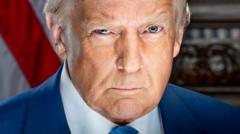The recently unveiled official portrait of Donald Trump, captured by his chief photographer Daniel Torok, is stirring a mix of reactions, with many labeling it as serious and ominous. The portrayal shows the president-elect in a stern light, eyebrow raised, prompting debate around its visual effects and underlying messages.
Former White House photographer Eric Draper, who captured portraits for George W. Bush, suggests that this image is notably “heavily manipulated.” He emphasizes that the lighting utilizes an unconventional technique, described as “monster” lighting, to dramatically illuminate Trump from below, which, according to photography expert Eliska Sky, creates an “ominous” feel typically associated with horror genres.
Sky likened Trump's demeanor in the portrait to that of a boxer preparing for a match, while Paul Duerinckx, a senior documentary photography lecturer, pointed out the striking impact of the lighting, contrasting it with traditional portrait approaches where the light source is typically above.
The contrast between Trump's new official portrait and prior images, including his 2017 version, is significant, with many noting the shift towards a more serious aesthetic. This contrast raises questions about the strategic choices behind political portraits, as Andrew Parsons, a political photographer, pointed out that such images often convey vital messages rather than candor.
Moreover, comparisons to Trump’s widely circulated mug shot, taken amid legal troubles, reveal another layer of cultural resonance, with discussions of its influence on the official portrait’s inspiration. Photography YouTuber Jared Polin reported that Torok acknowledged the mug shot’s cultural imprint, foregrounding the dynamic interplay between public perception and political imagery.
In today’s political landscape, the power of imagery cannot be overstated. As Parsons asserts, “A picture can make or break a political campaign,” highlighting the crucial nature of visual representation in modern governance.



















